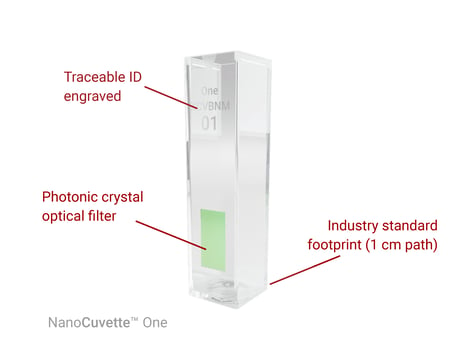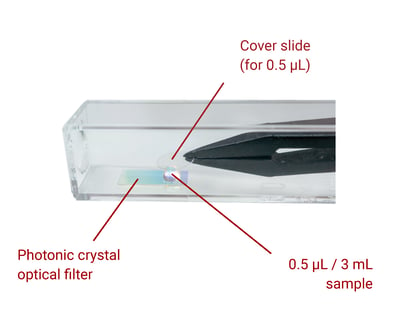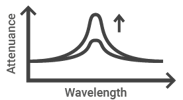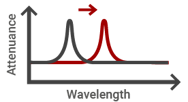NanoCuvette™ One - Product Brief
The NanoCuvette™ One is an excellent improvement in any laboratory workflow for quantitative analysis in numerous industries such as biotechnology, pharmaceuticals, chemistry, foods and industrial applications for quality control.
Download pdf here.
Key uses:
- Measurements at different volumes (0.5 μl, 3 mL) and concentrations (0.02 - 300 mg/mL)
- Non-absorbing protein concentrations
- Monitoring label-free enzymatic reactions
- Monitoring non-absorbing/non-fluorescent kinetics
- QC measurements
Key features:
- Affordable upgrade for your existing UV-Vis spectrophotometer
- Semi-reusable cuvettes
- Less sample needed for analysis
- Made in Denmark with unique ID for traceability
- Easy to use with no training required
Overview
The NanoCuvette™ One is an excellent improvement in any laboratory workflow for quantitative analysis in numerous industries such as biotechnology, pharmaceuticals, chemistry, foods and industrial applications for quality control.
The capacity of NanoCuvette™ One goes far beyond any product currently on the market in terms of concentration determination. With the NanoCuvette™ One you are able to analyze smaller samples (down to 0.5 μL) and a large range of concentrations (0.02 - 300 mg/mL) of non-absorbing compounds.

Together with the unique free online software SpectroWorks™ it is possible to calculate a number of different results of a sample, such as concentrations and user-defined parameters. Thereby, you can determine concentrations without any dye or fluorescence for compounds such as carbohydrates, proteins or perform chemical or enzymatic kinetic studies.
NanoCuvette™ One key uses:
Less sample needed for analysis
Enzymes and proteins can be expensive, some equipment needs 2 to 3 μL to measure protein. The NanoCuvette™ One can measure volumes down to 0.5 μL and concentrations down to 0.2 mg/mL for sucrose (Limit of detection is below 0.2 mg/mL sucrose concentration).
Label-free concentration determination
NanoCuvette™ One’s optical filter measures refractive index and together with SpectroWorks™ it will calculate the refractive index similar to SPR. Refractive index does not require any coloration (dye or indicator) to be measured. Thus it is possible to measure concentrations with a spectrophotometer of a transparent solution.
Monitoring label-free enzymatic reactions
Direct label-free detection of enzymatic activity with a substrate can be monitored with the change in the intrinsic property refractive index of the solution as product is formed over time. The NanoCuvette™ One has a built-in optical filter allowing it to measure refractive index changes due to enzymatic reaction kinetics in real time using an UV-Vis spectrophotometer.

Absorption versus label-free spectroscopy
With absorption spectroscopy, the Beer–Lambert law relates the attenuation of light to the properties of the material through which the light is traveling:
A = εcl + A0 ,

where A is the absorbance, ε is molar extinction coefficient, c is the concentration, l is the path length and A0 is the background absorbance. In contrast, when light hits a nanoscale photonic crystal, the resonance wavelength is related to the refractive index or concentration close to the surface:
λ = β(αc + ns) + λ0 ,

where λ is the wavelength, β is a coefficient, α is the specific refractive increment, c is the concentration, ns is the solvent refractive index and λ0 is the reference resonance wavelength. This is called label-free spectroscopy
Why do we upgrade UV-Vis spectrophotometry?
Traditionally, spectrophotometry laboratory work has been limited by lack of robust methods to determine concentrations. We upgrade UV-Vis spectrophotometry around the world and across all major instrument brands to create new ways to determine concentration, perfom enzymatic studies in a label-free, fast, cheap, and reliable method.
Contact us for more information